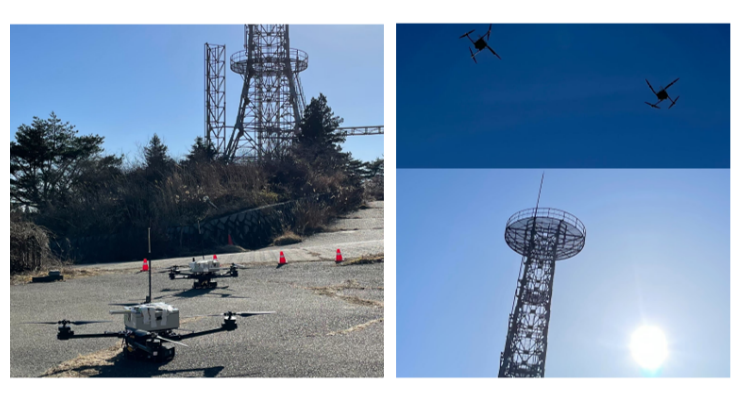Microsoft ends support for Internet Explorer on June 16, 2022.
We recommend using one of the browsers listed below.
- Microsoft Edge(Latest version)
- Mozilla Firefox(Latest version)
- Google Chrome(Latest version)
- Apple Safari(Latest version)
Please contact your browser provider for download and installation instructions.
May 15, 2023
NTT Corporation
World's first demonstration test of technology to enable non-stop inspection of windmills
NTT (Headquarters: Chiyoda-ku, Tokyo, Japan, President and CEO: Akira Shimada) has started a demonstration test of a technology that enables the world’s first non-stop inspection of wind turbines.
In this technology, the Extremely Low-power radio signals are transmitted and received between two drones flying with the structure under inspection sandwiched between them, and changes in the received signals are analyzed to detect whether the structure under inspection is damaged in the Fresnel zone *1. (Figure 1)
In the past, windmills were stopped for inspection, resulting in a decrease in power generation efficiency. This technology aims to contribute to carbon neutrality by improving power generation efficiency. This technology was first exhibited at the Tsukuba Forum 2023 in Tsukuba-shi, Ibaraki, Japan*2.
 Figure 1. Images of technology utilization
Figure 1. Images of technology utilization
1. Background
Offshore wind power, one of the renewable energy sources, is expected to be the main source of electricity in the future, with the aim of achieving carbon neutrality in 2050 and increasing Japan’s energy self-sufficiency rate. The installation target *3 is about 10 million kW in 2030 and about 30 million kW to 45 million kW in 2040. In order to achieve the installation target, approximately 3,600 *4 offshore wind turbines will be constructed along the coast of Japan as of 2040. Moreover, not only construction but also maintenance and operation efficiency are expected to be issues and given the environmental conditions in which transportation and on-site work are difficult, it will be important to realize maintenance and operation with as little human intervention as possible *5. In addition, the assumed capacity factor *6 for offshore wind power generation is 30%*7, and improving this factor is another issue.
Accordingly, NTT has been engaged in research and development that combines wireless technology, which it has cultivated in the telecommunications business, with drone control technology, with the aim of increasing operational efficiency by automating periodic inspections of offshore wind farms and improving equipment utilization by shortening downtime.
2. Key points of technology
- Using autonomous drones as radio transmitters and receivers
- Uses the Extremely Low-power radio without a radio station license, so can operate anywhere
- Fresnel zone determined by frequency and transmit/receive distance can be easily changed
- Changes in received signal can be detected in Fresnel zone
3. Experiments and Results
① Demonstration of damage detection by change of received signal in Fresnel zone in laboratory
To verify that this technology can detect whether a structure is damaged or not, we conducted an indoor experiment to detect changes in received signals in the Fresnel zone in a laboratory with low noise effects. This detection is intended to be used prior to inspections using existing technologies, such as imaging and analysis performed while the windmill is stopped. That’s why it’s important to know if it can be used to determine shutdown standards. In this experiment, we aimed to determine the condition of blade damage during rotation by comparing the normal condition with the three conditions described in the blade inspection guidelines *8 for wind power plants (Figure 2). As a result, we were able to detect the presence or absence of damage during planned repairs that affect operation and conditions that require security shutdown (Figure 3).
 Figure 2. Damage level to be determined
Figure 2. Damage level to be determined
 Figure 3. Indoor experiments
Figure 3. Indoor experiments
② Demonstration of transmission and reception of the Extremely Low-power radio outdoors
We conducted outdoor experiments using two drones to send and receive the Extremely Low-power radio in the sky. Although d the sky is an environment that is often affected by noise,, we took countermeasures and conducted experiments that successfully demonstrated the Extremely Low-power radio transmission and reception at an altitude of 30 meters (Figure 4). We also confirmed that the Fresnel zone can be easily changed by operating two autonomous drones *9 to change the transmission and reception distance in the sky as intended.
 Figure 4. Outdoor experiments
Figure 4. Outdoor experiments
4. Future developments
In order to establish the technology, we plan to conduct experiments using this technology on several wind-powered windmills that are actually being operated outdoors, and to confirm that damage detection can be performed even on actual windmills outdoors.
Through further research and demonstration experiments, we aim to contribute to carbon neutrality by increasing the operational efficiency of offshore wind power generation through the automation of periodic inspections and by increasing the capacity utilization rate.
<Glossary>
*1Fresnel zone
Space where radio waves propagate, determined by the distance and frequency of radio transmission and reception
*2Tsukuba Forum 2023
https://www.tsukuba-forum.jp/
*3The Ministry of Economy, Trade and Industry「Offshore Wind Industry Vision (First)」
*4Estimated by NTT based on 12600 kW/plant in "Round 1," which is designated as an accelerated zone based on the Act on the Use of Renewable Energy Waters.
*5The Ministry of Economy, Trade and Industry 「Survey on Offshore Wind Power Generation Facilities Overseas, February 2022」
*6Capacity utilization
The ratio of the amount of electricity actually generated in 1 year to the amount of electricity generated when running at 100% rated output (24 hours, 365 days)
*7Materials of the Procurement Calculation Committee, Ministry of Economy, Trade and Industry, from February 8, 2023
*8Japan Wind Power Association "Wind Power Plant Blade Inspection and Repair Guidelines"
*9Stable flight of two autonomous drones was commissioned by Japan Infrastructure Waymark Co., Ltd., a member of the NTT West Group.
Media Contact
NTT Information Network Laboratory Group
Planning Department, Public Relations Section
nttrd-pr@ml.ntt.com
Information is current as of the date of issue of the individual press release.
Please be advised that information may be outdated after that point.
NTT STORY
WEB media that thinks about the future with NTT










